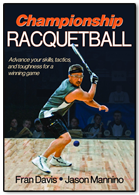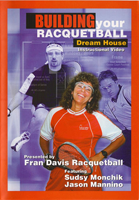
NO ONE is exempt from injury as it is part of being involved in sports. It can range from minor, like a light strain or pulled muscle, to severe, like a torn ligament/meniscus or major tendinitis. Racquetball is a racquet sport that is quick with lots of change of direction and explosion so be as prepared as possible.
In my career I have been a witness to so many injured racquetball players (including myself with a slight tear in the rotator cuff) who took the necessary steps to comeback from their injury as strong, if not stronger than before:
-Rocky Carson, in July 2017 tore his meniscus…still # 1 IRT Pro Player and made the finals or semis in every tournament since coming back from his injury.
-Paola Longoria, in 2010 tore her ligaments in her right ankle…since then achieved #1 9X LPRT Pro Player & 7X US Open Champion.
-Jason Mannino, mid 90’s broke his back in 4 places……achieves # 1 IRT Pro Player in 2003.
-Sudsy Monchik, broke his foot and was out for 6+ months…his 1st tournament back won the US Open for the 5th time.
Here are the 4 Steps for “Coming Back from an Injury” I’ve learned over the years from Diana McNab, former Sports Psychologist of the USA Racquetball Team, and other sports specialists. The players I referenced above followed these steps religiously and their results speaks for themselves:
Step #1 Accept You Are Injured…don’t deny it, ignore it, but rather embrace it. Do not play with it…it usually gets worse and becomes more serious:
-Seek a professional opinion.
-Stick to your rehab program set forth by your medical professional.
-Don’t let your injury get you down…focus on turning it into a positive (it may be a blessing in disguise, you never know).
Step #2 Take this Time to Refocus, Regroup and Take a Good Hard Look at Yourself:
-Use your injury as a time to rest…we often play year round with no time off.
-Re-evaluate your training program as sometimes an injury is just bad luck or it can be due to overtraining.
-Use this time to get stronger…lift weights, visualize, stretch, etc.
-Re-access your game…and don’t lose prospective. Re-visit your goals, attitude, coach, fitness and conditioning levels, nutrition and physical game.
-Enjoy the time off…an opportunity to regain balance in your life.
Step #3 What to Actually Do:
-Drink plenty of water.
-Eat plenty of protein for tissue repair.
-Visualization on a daily basis.
-Watch tapes of yourself, mentors, professionals, etc.
-Practice stress management…. relaxation, breathing exercising, meditation and/or stretching.
-Use massage therapy.
-Use affirmation statements.
-Follow your prescription, if applicable, from your professional advisor…don’t deviate when you start feeling better, as too many people do and are vulnerable to re-injury.
Step #4 The Comeback:
-Take it slow…it’s better to crawl, then walk, then run…don’t come out of the blocks running because if you overdo it too quickly the re-injury is worse the second time around.
-Get into playing shape…slowly…walk, then walk/run, then light jogging or biking or rowing or etc.
-Get your timing back…ease into it…drill first (stationery 1st, then moving). Too often players set up matches right off the bat and that’s where the trouble begins. As you get stronger start to arrange matches with players one level below you and then one level equal to you. Take it one step at a time.
-Stretch on a regular basis.
-Continue to weight train according to the doctor’s prescription.
-Limit your expectations and be realistic. If you put too much pressure on yourself to perform as if you weren’t injured, you could be setting yourself up for failure rather than success and breaking your confidence.
-Have faith in the future…. after your injury you’ll face many emotional challenges such as fear of re-injury, fear that you will never regain your strength, speed or flexibility and you lose your confidence.
– Stay POSITIVE and follow the course 1 step at a time.
Use the techniques in my book “Championship Racquetball”, Chapter 9 Maintaining Mental Toughness & 10 Conditioning and Flexibility, for more details on “Coming Back from an Injury”.
Remember an injury can be traumatic. Besides the physical pain, it can create fear and a severe loss of confidence. As a matter of fact, we don’t realize that the emotional healing sometimes can be as important, if not more important, than the physical healing. “Coming Back from an Injury” is yet another required skill on the road to championship racquetball. ALL of the players I coach, from the professionals led by Rocky and Paola to the amateurs, know just how important it is to utilize this “4 Step Approach to Injuries”, as they are living proof it works.
In the next issue, I will continue to build your Championship Racquetball Game one level at a time so you too can be ready to become the champion you always dreamed of becoming, by giving you the tools to make it a reality. Rocky and all my athletes “Championship Racquetball Games” stem from their focus on ALL 3 sides of the triangle working together so they can develop into top competitors. Without a shadow of a doubt, they KNOW just how important it is to do the work as their records speak for themselves.
(original article posted on irt-tour.com)
Check out my coaching tips on my website, www.FranDavisRacquetball.com










